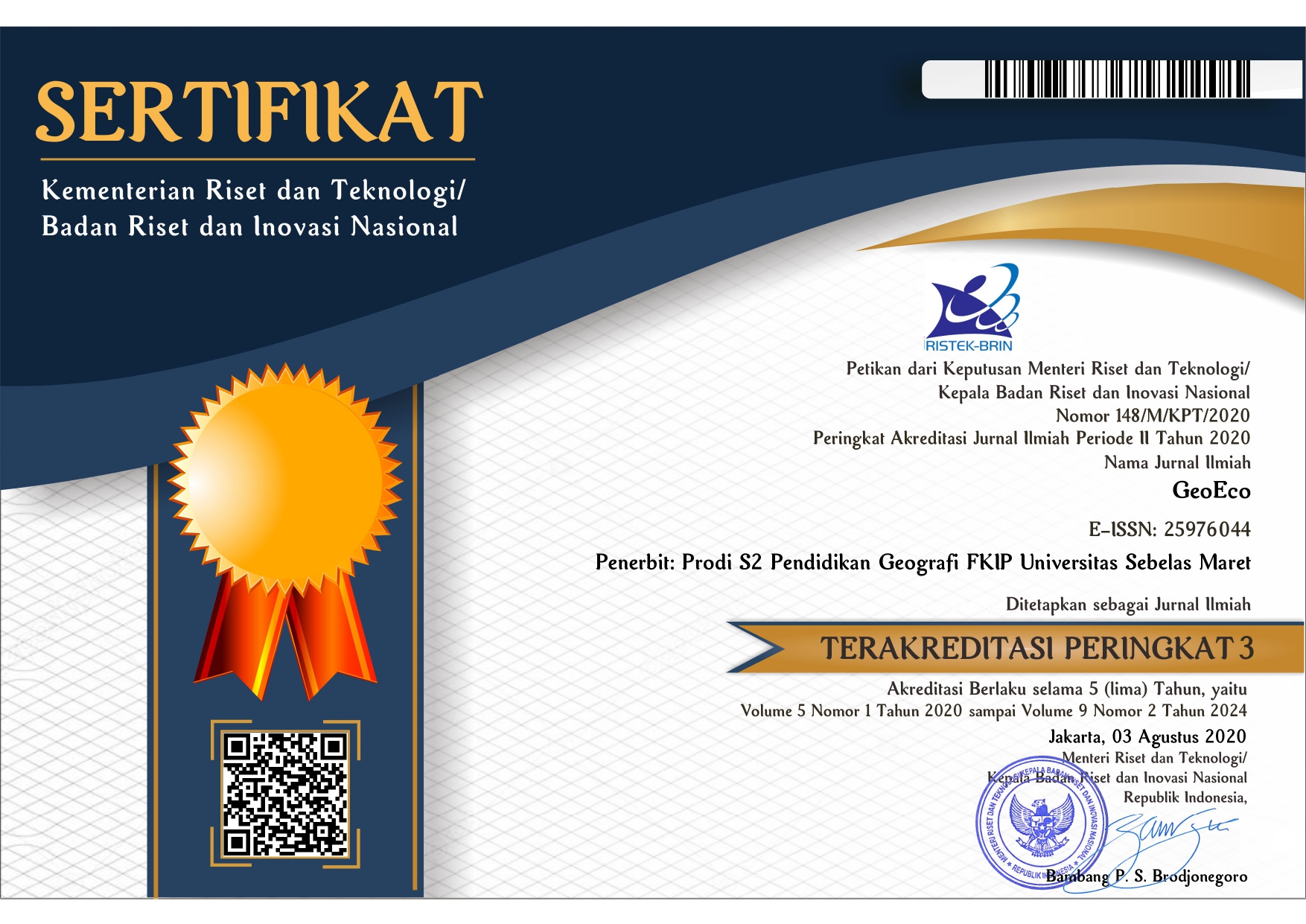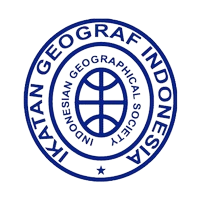ESTIMATED SUPPLY OF GREEN OPEN SPACE IS BASED ON OXYGEN CONSUMPTION AND MICRO TEMPERATURES IN CARUBAN CITY
Abstract
Local governments must provide a public green space for 20% of the total city area. In addition for aesthetic value and beauty that is used as source of public recreation and green space that used to create cooler microclimate temperatures, maintain the balance of oxygen (O2) and carbondioxide (CO2), reduce pollutants, and help maintain water availability soil. Research aims to analyze and calculate the needs of Caruban City Green Space. Research used survey method with purposive sampling technique and secondary data analysis. Temperature analysis used the thom formula, while the analysis the needs of green space with the Geravkis method. Results of study showed that in six places had relatively cooler temperatures ranging from 26-31°C in the afternoon, 26-33°C in the morning, and in the middle of afternoon about 29 to 33°C. Data showed that in one place, namely, Ahmad Yani road showed the temperature about 31-36.5°C was relatively hot. Oxygen demand in 2020 requires a full green space of 133.92 ha. The results of this study are expected to provide recommendations in the application of Spatial Planning Law Number 26 of 2007 concerning spatial planning to improve the comfort of Caruban City dwellings in terms of the air environment.
Keywords
Full Text:
PDFReferences
BPS. (2019a). Kabupaten Madiun Dalam Angka. BPS Kabupaten Madiun. BPS. (2019b). Kecamatan Mejayan Dalam Angka. BPS Kabupaten Madiun. Dasuka, Y. P., Sasmito, B., & Hani’ah. (2016). Analisis sebaran jenis vegetasi hutan alami menggunakan sistem penginderaan jauh. Jurnal Geodesi Undip, 5(2), 1–8. Peraturan Menteri Pekerjaan Umum Nomor: 05/PRT/M/2008, 57 (2008). Humaida, N., Prasetyo, L. B., & Rushayati, S. B. (2016). Priority Assessment Method of Green Open Space (Case Study: Banjarbaru City). Procedia Environmental Sciences, 33(December), 354–364. https://doi.org/10.1016/j.proenv.2016.03.086 Peraturan Pemerintah Republik Indonesia Nomor 3 Tahun 2019 Tentang Perubahan Atas Peraturan Pemerintah Nomor 52 Tahun 2010 Tentang Pemindahan Ibu Kota Kabupaten Madiun Dari Wilayah Kota Madiun ke Wilayah Kecamatan Mejayan Kabupaten Madiun Provinsi Jawa Ti, Pub. L. No. Peraturan Pemerintah Republik Indonesia No. 3 Tahun 2019, 7 (2019). Pancawati, J. (2010). Analisis Kebutuhan Ruang Terbuka Hijau Di Kota Tangerang. In Bogor Agricultural University. IPB (Bogor Agricultural University). Prasetyo, A. T. (2012). Pengaruh Ruang Terbuka HIjau (RTH) Terhadap Iklim Mikro di Kota Pasuruan. UM. Purwatik, S., Sasmito, B., & Hani’ah. (2014). Analisis Ketersediaan Ruang Terbuka Hijau (RTH) Berdasarkan Kebutuhan Oksigen. Jurnal Geodesi Undip, 3(3), 124–135. Samsudi. (2010). Ruang Terbuka Hijau Kebutuhan Tata Ruang Perkotaan Kota Surakarta. Journal of Rural and Development, Vol. 1(No. 1), Hal. 11-19. Santi, Belinda, S., Rianty, H., & Aspin. (2019). Identifikasi Iklim Mikro Dan Kenyaman Termal Ruang Terbuka Hijau Di Kendari. NALARs, 18(1), 23–33. https://doi.org/10.24853/nalars.18.1.23-34 Setyani, W., Sitorus, S. R. P., & Panuju, D. R. (2017). Analisis Ruang Terbuka Hijau Dan Kecukupannya Di Kota Depok. Buletin Tanah Dan Lahan, 1(1), 121–127. Tjasyono, B. (2004). Klimatologi. ITB Press. Wati, T., & Fatkhuroyan, F. (2017). Analisis Tingkat Kenyamanan Di DKI Jakarta Berdasarkan Indeks THI (Temperature Humidity Index). Jurnal Ilmu Lingkungan, 15(1), 57. https://doi.org/10.14710/jil.15.1.57-63 Xiao, X. D., Dong, L., Yan, H., Yang, N., & Xiong, Y. (2018). The Influence of The Spatial Characteristics of Urban Green Space on The Urban Heat Island Effect in Suzhou Industrial Park. Sustainable Cities and Society, 40, 428–439.
Refbacks
- There are currently no refbacks.












.png)

